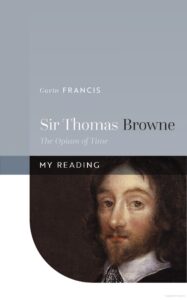Arpan K. Banerjee
Solihull, UK

Sir William Osler was a great admirer of Sir Thomas Browne’s 1643 Religio Medici, one of his favorite books and on his recommended reading list for medical men. Browne influenced many writers, such as Samuel Johnson, WG Sebald, Jorge Luis Borges, Joseph Conrad, and EM Forster. In this slim volume, Gavin Francis, a family doctor and author, has produced a magnificent homage to the now little-read Browne in a reflective analysis of his life and writings.
In addition to his rural clinical practice in Norwich, Thomas Browne found time to write books on faith, knowledge, mortality, and how to live a good life. He was one of the most original writers in the English language and coined almost a thousand new words such as ambidextrous, ascetic, hallucination, indigenous, and herbaceous. He wrote in a classical “elevated” style and has produced some of the beautiful and memorable passages in the English language.
Thomas Browne studied in Oxford and traveled widely in Europe to obtain his clinical medical training in Montpellier, Padua, and Leiden. He settled in Norwich, UK, where he practiced as a physician all his life and continued his literary endeavours. He sought no office or honors and obtained a knighthood by pure chance, not through ambition. Browne realized he was not an original scientific mind of the first rank, but his prodigious curiosity about the world around him resulted in his many published books and essays. He was prone to circumlocutions, ambiguity, and inconsistencies, which were all features of his prose. He was also given to flights of sublime speculation.
It is interesting that today doctors are encouraged to be honest with their patients and admit that their knowledge is not all-encompassing or comprehensive. Medicine is fraught with uncertainty, something that Thomas Browne knew over 300 years ago.
Curiosity was another great defining characteristic of Thomas Browne. Virginia Woolf described his mind as being circled by “a halo of wonder.” His restless curiosity led him to conduct experiments with animals based on empirical observations. The wide range of inquiries he undertook are described in his 1646 book Pseudodoxia Epidemica, or Vulgar Errors.
Browne was a man of struggle where faith was concerned. He was simultaneously rigid and flexible in his beliefs, and though he believed that patients relied on doctors’ diagnostic and therapeutic skills, he was constantly wracked by doubt. He regularly prayed for his patients.
Humility was extremely important for Thomas Browne. He acknowledged his limitations long before it was fashionable to do so. His clinical encounters with patients enabled him to indulge his prodigious curiosity about humans and use these to good literary effects. He was interested in mortality and wrote a fine meditative essay, “Urn Burial,” where he reviewed the funerary practices of ancient antiquity and reflected on death. Browne realized that life was temporary and death inevitable, and that the job of a doctor was to relieve human suffering, preserve the living, and possibly keep them out of the urns. He understood that often all doctors can do is postpone the inevitability of death. He knew the pain of bereavement first-hand, having lost five of his ten children before they reached adulthood. In his writing, early references to palliative care can be found in “A Letter to a Friend” from 1656.
Browne regarded life as a cathedral of mystery, something to be explored to the full and lived. He believed we would all be forgotten after death and that “we should see the worth of our work in our life and not in memorials after death.”
In this book, the author has produced a fine reflective work on Browne’s life and writings.
Although not written as a traditional biography, the biographical material and quotes from his writings accompany the beautifully written analysis, creating a book that reads well and is a fine introduction to the life and work of this remarkable seventeenth century physician.
Sir Thomas Browne: The Opium of Time
Gavin Francis, Oxford University Press, 2023
ISBN 9780192858177
ARPAN K. BANERJEE, MBBS (LOND), FRCP, FRCR, FBIR, qualified in medicine at St. Thomas’s Hospital Medical School, London. He was a consultant radiologist in Birmingham from 1995–2019. He served on the scientific committee of the Royal College of Radiologists 2012–2016. He was Chairman of the British Society for the History of Radiology from 2012–2017. He is Chairman of ISHRAD and adviser to Radiopaedia. He is the author/co-author of numerous papers and articles on a variety of clinical medical, radiological, and medical historical topics and seven books, including Classic Papers in Modern Diagnostic Radiology (2005) and The History of Radiology (OUP 2013).

Leave a Reply